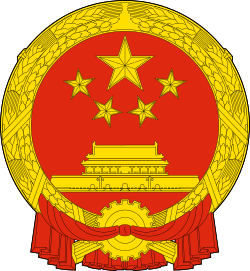Civil Aviation Administration of China
| 中国民用航空局 | |
 | |
| Agency overview | |
|---|---|
| Formed | 1949 |
| Jurisdiction |
|
| Headquarters | Dongcheng District, Beijing |
| Agency executive |
|
| Parent agency | Ministry of Transport |
| Website |
www |
The Civil Aviation Administration of China (CAAC; simplified Chinese: 中国民用航空局; traditional Chinese: 中國民用航空局; pinyin: Zhōngguó Mínyòng Hángkōng Jú), formerly the General Administration of Civil Aviation of China (simplified Chinese: 中国民用航空总局; traditional Chinese: 中國民用航空總局; pinyin: Zhōngguó Mínyòng Hángkōng Zǒngjú), is the aviation authority under the Ministry of Transport of the People's Republic of China. It oversees civil aviation and investigates aviation accidents and incidents.[1] As the aviation authority responsible for China, it concludes civil aviation agreements with other aviation authorities, including those of the Special Administrative Regions of the People's Republic of China which are categorized as "special domestic".[2] The agency is headquartered in Dongcheng District, Beijing.[3]
The CAAC does not share the responsibility of managing China's airspace with the Central Military Commission under the regulations in the Civil Aviation Law of the People's Republic of China (中华人民共和国民用航空法, Zhōnghuá Rénmín Gònghéguó Mínyòng Hángkōng Fǎ).
History
CAAC was formed on November 2, 1949, shortly after the founding of the People's Republic of China, to manage all non-military aviation in the country, as well as provide general and commercial flight service (similar to Aeroflot in the Soviet Union). It was initially managed by the People's Liberation Army Air Force.

In 1963, China departed from its policies of Marxist self-sufficiency with a purchase of six Vickers Viscount aircraft from Great Britain, followed in 1971 with four Hawker Siddeley Trident aircraft from Pakistan International Airlines. In August 1971 the airline purchased six Trident 2E's directly from Hawker Siddeley.[4] The country also placed provisional orders for three Concorde aircraft. With the 1972 Nixon visit to China the country ordered 10 Boeing 707 jets. In December 1973 it took the unprecedented step of borrowing £40 million from Western banks to fund the purchase of 15 additional Trident jets. Russian built Ilyushin Il-62 aircraft were used on long range routes during the 1970s and 1980s.
In 1980 the airline was transferred to the direct control of the State Council.
In 1987 the airline division of CAAC was divided up into a number of airlines, each named after the region of China where it had its hub. Since then, CAAC acts solely as a government agency and no longer provides commercial flight service.
In March 2008, CAAC was made a subsidiary of the newly created Ministry of Transport, and its official Chinese name was slightly adjusted to reflect it being no longer a ministry-level agency. Its official English name has remained Civil Aviation Administration of China.
CAAC as an airline
 | |||||||
| |||||||
| Founded | 1949 | ||||||
|---|---|---|---|---|---|---|---|
| Commenced operations | 1929 (as China National Aviation Corporation) | ||||||
| Ceased operations | 1987 (Split into six airlines) | ||||||
| Hubs |
Beijing Capital Shanghai Hongqiao Guangzhou Baiyun Chengdu Shuangliu Xi'an Xiguan (closed in 1991) Shenyang Taoxian | ||||||
| Destinations | 85 Cities, In 25 Countries (As of 1987) | ||||||
| Parent company | State Council | ||||||
| Headquarters | Beijing, China | ||||||
| Key people | Director of the General Office | ||||||


_06.jpg)
CAAC began operating scheduled domestic flights to cities in China in 1949.
In 1962, CAAC began operating international services, initially to other countries in the Communist bloc such as the Soviet Union, Mongolia, North Korea, Burma, Bangladesh, North Vietnam, and Cambodia.[6] By the mid-1980s, CAAC had long-haul service to the United States, Europe, the Middle East, and Australia, mainly using American Boeing aircraft, while continuing to use Soviet aircraft on routes to Eastern Europe.[7]
The Boeing customer code for CAAC was J6, which was inherited by Air China until 1999.
Separation
In 1987, CAAC's airline operations split into 6 separate airlines each named after the geographic region of the location of their headquarters and main operation areas:
- Air China (which inherited the IATA and ICAO code of the original CAAC),
- China Southwest Airlines (merged with Air China in 2002, originally based in Chengdu)
- China Eastern Airlines (based in Shanghai)
- China Northwest Airlines (merged with China Eastern in 2002, originally based in Xi'an)
- China Southern Airlines (based in Guangzhou)
- China Northern Airlines (merged with China Southern in 2003, originally based in Shenyang)
CAAC used the IATA code CA on international flights only; domestic flights were not prefixed with the airline code.
CAAC aircraft livery featured Chinese national flag on the vertical stabilizer, with blue stripes and Chinese version of CAAC logo (autographed by Zhou Enlai) on a white fuselage.
CAAC's fleet in 1987
- Airbus A310
- Antonov An-12
- Antonov An-24/Xian Y-7
- Antonov An-30
- BAe 146
- Boeing 707
- Boeing 737-200
- Boeing 747SP
- Boeing 747-200
- Boeing 767
- Hawker Siddeley Trident 2E
- Ilyushin Il-18
- McDonnell Douglas MD-82
- Tupolev Tu-154B
- Tupolev Tu-154M
- Vickers Viscount
- Yakovlev Yak-42
General aviation
Fleet retired before 1987
- Ilyushin Il-14 (Left service in 1982)
- Ilyushin Il-62 (Left service in 1986)
- Lisunov Li-2 (Left service in 1981)
- Shanghai Y-10 (Prototype, flew for less than a year, did not enter into service)
- Vickers Viscount (Left service in 1984)
Major incidents
- April 5, 1958
- CAAC Ilyushin Il-14 632 crashed 44 mi from Xi'an, killing all 14 on board.[8]
- September 26, 1961
- CAAC Shijiazhuang Y-5 18188 struck the side of a mountain at Qinglongshan, Henan Province, killing all 15 on board.[9]
- May 1972
- A CAAC Lisunov Li-2 overshot the runway at Dalian Airport, killing 6 occupants.
- January 14, 1973
- CAAC Ilyushin Il-14 644 struck a mountain near Guiyang, killing all 29 on board.[10]
- January 21, 1976
- CAAC Antonov An-24 B-492 crashed on approach to Changsha Huanghua International Airport, killing all 40 on board.[11]
- August 26, 1976
- A CAAC Ilyushin Il-14 crashed during landing in Chengdu, killing 12 passengers.
- March 14, 1979
- CAAC Hawker Siddeley Trident 2E B-274 crashed into a factory in Beijing on climbout from Xijiao Airport during a training flight, killing all 12 on board and 32 on the ground.[12]
- March 20, 1980
- CAAC Antonov An-24RV B-484 crashed and burned near Huanghua Airport, killing all 26 on board.[13]
- April 26, 1982
- CAAC Flight 3303, a Hawker Siddeley Trident 2E (B-266), crashed into a mountain near Yangshuo while on approach to Guilin, killing all 112 on board.
- December 24, 1982
- CAAC Flight 2311, an Ilyushin Il-18B (B-202), burst into flames while landing at Guangzhou Baiyun Airport, killing 25 of 69 on board.[14]
- May 5, 1983
- CAAC Hawker Siddeley Trident 2E (B-296) was hijacked and landed at a U.S. military base in South Korea. The incident marked the first direct negotiations between South Korea and China, which did not have formal relations at the time.[15]
- September 14, 1983
- CAAC Hawker Siddeley Trident 2E B-264 collided with a Harbin H-5 bomber while taxiing at Guilin Airport. 11 of 106 on board were killed.[16]
- January 18, 1985
- CAAC Flight 5109, an Antonov An-24B (B-434), crashed in drizzle and fog while performing a missed approach to Jinan, killing 38 of 41 on board.[17]
- December 15, 1986
- CAAC Antonov An-24RV B-3413 crashed while attempting to return to Lanzhou after an engine failed due to icing, killing 6 of 44 on board.[18]
- June 16, 1987
- CAAC Boeing 737-2T4 B-2514 collided with a Shenyang J-6 at Fuzhou Airport; the J-6 crashed, killing the pilot while the 737 landed safely.[19]
- August 31, 1988
- CAAC Flight 301, a Hawker Siddeley Trident 2E (B-2218), struck approach lights at Kai Tak Airport and struck a lip, collapsing the right main landing gear; the aircraft then slid off the runway into Kowloon Bay, killing 7 of the 89 on board. The cause was undetermined, but windshear may have been a factor.
- December 16, 1989
- CAAC Flight 981 (operated by Air China), a Boeing 747-200BM (B-2448), was hijacked while flying the Beijing-Shanghai-San Francisco-New York City route. The hijacker's intended destination was Gimpo International Airport in Seoul, South Korea, but after South Korean authorities refused permission to land, the aircraft landed in Fukuoka Airport in Fukuoka, Japan. The hijacker was injured after being pushed out of the aircraft and was apprehended by Japanese authorities. The rest of the passengers and the crew were unharmed, and the aircraft returned to Beijing later that day.[20]
Affiliated universities
- Civil Aviation University of China (CAUC) in Tianjin
- Civil Aviation Flight University of China (CAFUC) in Sichuan
See also
- Transport in the People's Republic of China
- List of airports in the People's Republic of China
- China's busiest airports by passenger traffic
- List of airlines of the People's Republic of China
- Civil Aviation Department (Hong Kong)
- Civil Aviation Authority (Macau)
References
- ↑
- ↑ the citation is in the treaty "Air Services Arrangement between the Mainland and the Hong Kong Special Administrative Region" which calls intranational service as "specially managed domestic" this needs a proper ref statement.
- ↑ "English Archived September 6, 2009, at the Wayback Machine.." Civil Aviation Administration of China. Retrieved on June 9, 2009. "北京市东城区东四西大街155号."
- ↑ Tridents for China, Flight International, 2 September 1971, p. 348
- ↑ B-2448 was handed over to Air China in 1987.
- ↑ 1964 timetable scans Archived June 3, 2016, at the Wayback Machine.
- ↑ 1985 route map Archived March 4, 2016, at the Wayback Machine.
- ↑ Accident description for 632 at the Aviation Safety Network. Retrieved on 25 August 2014.
- ↑ Accident description for 18188 at the Aviation Safety Network. Retrieved on 21 January 2013.
- ↑ Accident description for 644 at the Aviation Safety Network. Retrieved on 25 August 2014.
- ↑ Accident description for B-492 at the Aviation Safety Network. Retrieved on 21 January 2013.
- ↑ Accident description for B-274 at the Aviation Safety Network. Retrieved on 21 January 2013.
- ↑ Accident description for B-484 at the Aviation Safety Network. Retrieved on 25 August 2014.
- ↑ Accident description for B-202 at the Aviation Safety Network. Retrieved on 21 January 2013.
- ↑ Hijacking description for B-296 at the Aviation Safety Network. Retrieved on 21 January 2013.
- ↑ Accident description for B-264 at the Aviation Safety Network. Retrieved on 21 January 2013.
- ↑ Accident description for B-434 at the Aviation Safety Network. Retrieved on 21 January 2013.
- ↑ Accident description for B-3413 at the Aviation Safety Network. Retrieved on 21 January 2013.
- ↑ Accident description for B-2514 at the Aviation Safety Network. Retrieved on 2016-6-30.
- ↑ Accident description for B-2448 at the Aviation Safety Network. Retrieved on 25 August 2014.
External links
| Wikimedia Commons has media related to Civil Aviation Administration of China. |
- CAAC Official site (simplified Chinese)
- CAAC Official site (Archive)
- Flight Inspection Center of CAAC (English)/(simplified Chinese)
- China - Civil Aviation
- Civil Aviation Management Institute of China, Civil Aviation Safety Institute (simplified Chinese)

